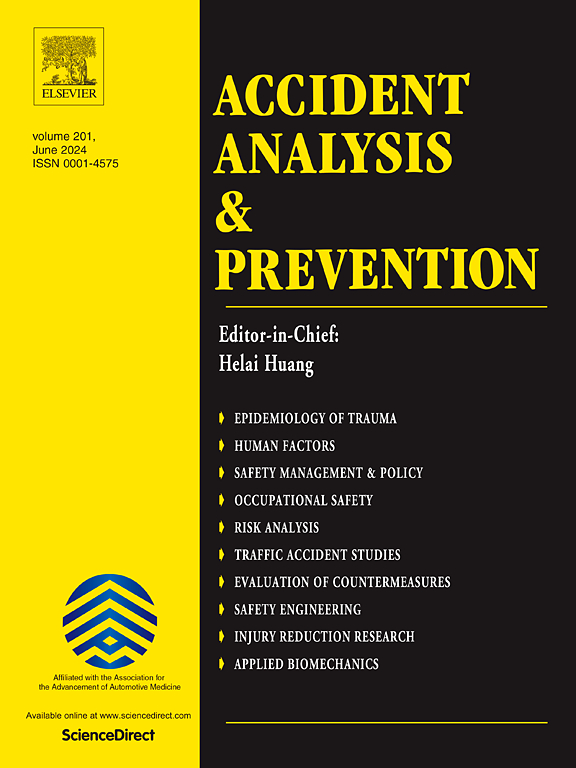Cooperative control of self-learning traffic signal and connected automated vehicles for safety and efficiency optimization at intersections
IF 5.7
1区 工程技术
Q1 ERGONOMICS
引用次数: 0
Abstract
Cooperative control of intersection signals and connected automated vehicles (CAVs) possess the potential for safety enhancement and congestion alleviation, facilitating the integration of CAVs into urban intelligent transportation systems. This research proposes an innovative deep reinforcement learning-based (DRL) cooperative control framework, including signal and speed modules, to dynamically adapt signal timing and CAV velocities for traffic safety and efficiency optimization. Among the DRL-based signal modules, a traffic state prediction model is merged with the current state to augment characteristics and the agent-learning process. A multi-objective reward function is designed to evaluate safety and efficiency using a traffic conflict prediction model and vehicle waiting time. The double deep Q network (DDQN) model is used to design the agent observing the traffic state, learning the optimal signal control policy, and then inputting the signal phase into the speed module. Based on the green duration analysis and constraints of mixed traffic flow of CAVs and human-driven vehicles, a speed planning model is constructed to optimize CAVs’ speed and alter traffic state, which in turn affects the agent’s next signal decisions. The proposed framework is tested at isolated intersections simulated by two real-world intersections in Changsha, China. The results reveal the superiority of the proposed method over DRL-based traffic signal control (DRL-TSC) in terms of coverage speed and computation time. Compared to actuated signal control, adaptive traffic signal control, and DRL-TSC, the proposed method significantly optimizes traffic safety and efficiency across diverse intersections, temporal spans, and traffic demands. Furthermore, the advantage of the proposed method substantially amplifies with the increased CAV penetration, regardless of the intersection types.
自主学习交通信号与互联自动车辆协同控制,优化交叉口安全与效率。
交叉口信号与网联自动驾驶汽车(cav)的协同控制具有增强安全性和缓解拥堵的潜力,促进了cav与城市智能交通系统的融合。本研究提出了一种创新的基于深度强化学习(DRL)的协同控制框架,包括信号和速度模块,以动态适应信号配时和自动驾驶汽车速度,以优化交通安全和效率。在基于drl的信号模块中,将交通状态预测模型与当前状态合并以增强特征和智能体学习过程。利用交通冲突预测模型和车辆等待时间,设计了一个多目标奖励函数来评价安全与效率。采用双深度Q网络(DDQN)模型设计智能体观察交通状态,学习最优信号控制策略,然后将信号相位输入到限速模块。基于对自动驾驶汽车和人类驾驶汽车混合交通流的绿时分析和约束,构建速度规划模型,优化自动驾驶汽车的速度和改变交通状态,进而影响智能体的下一个信号决策。该框架在中国长沙的两个真实交叉口模拟的孤立交叉口上进行了测试。结果表明,该方法在覆盖速度和计算时间上优于基于drl的交通信号控制方法。与驱动信号控制、自适应交通信号控制和DRL-TSC相比,该方法在不同的交叉口、时间跨度和交通需求下显著优化了交通安全和效率。此外,无论交叉口类型如何,该方法的优势都随着CAV穿透的增加而大大增强。
本文章由计算机程序翻译,如有差异,请以英文原文为准。
求助全文
约1分钟内获得全文
求助全文
来源期刊

Accident; analysis and prevention
Multiple-
CiteScore
11.90
自引率
16.90%
发文量
264
审稿时长
48 days
期刊介绍:
Accident Analysis & Prevention provides wide coverage of the general areas relating to accidental injury and damage, including the pre-injury and immediate post-injury phases. Published papers deal with medical, legal, economic, educational, behavioral, theoretical or empirical aspects of transportation accidents, as well as with accidents at other sites. Selected topics within the scope of the Journal may include: studies of human, environmental and vehicular factors influencing the occurrence, type and severity of accidents and injury; the design, implementation and evaluation of countermeasures; biomechanics of impact and human tolerance limits to injury; modelling and statistical analysis of accident data; policy, planning and decision-making in safety.
 求助内容:
求助内容: 应助结果提醒方式:
应助结果提醒方式:


